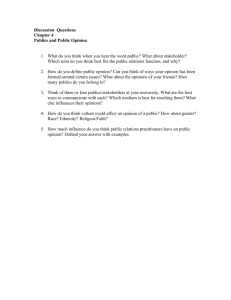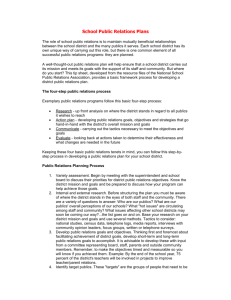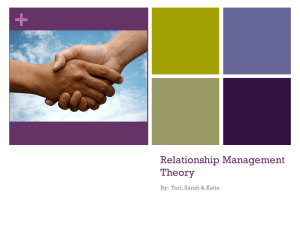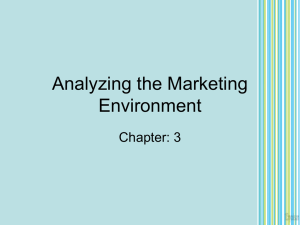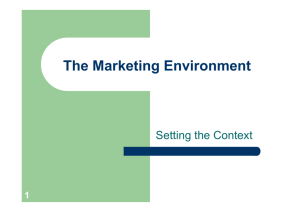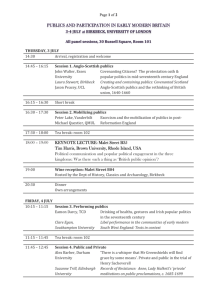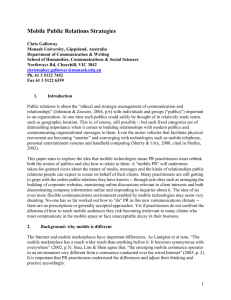Creating a Strategic Communications Plan Outline
advertisement
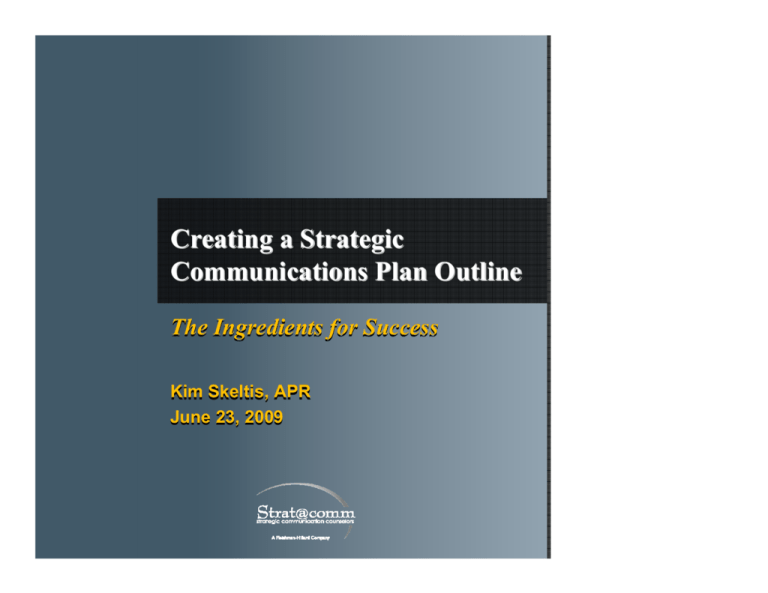
Creating a Strategic Communications Plan Outline The Ingredients for Success Kim Skeltis, APR June 23, 2009 Definition A strategic communications plan: Provides a roadmap based on research that tells: • • • What messages Delivered through which communication channels Influence audiences to take action (buy, partner, vote, etc.) Identifies, delivers and documents measurable results Supports company’s business objectives Is based on thorough understanding of audiences’ views toward organization 2 Plan Elements – Four-Step Process 1. Defining the Problem Situation Analysis Problem Statement 2. Planning and Programming Goals Target Publics Objectives 3. Taking Action/Communicating Strategies Tactics Implementation Plans (Timelines, Staffing, Budgets) 4. Evaluation 3 “Pyramid” Style 1 problem statement 1 or 2 goals A few more objectives (relating to one or more publics) More strategies LOTS of tactics! 4 Situation Analysis Unabridged description of all known about situation based on: Internal factors: statistics, position statements, mission, sales figures, history, charter, etc. External factors: media coverage analysis, survey results, comm. audit, published research, etc. May include SWOT analysis to organize findings Assessment is grounded in research 5 Research Methods Formal (structured – can be replicated) vs. informal Primary (firsthand) vs. secondary Quantitative (answers “how many”) vs. qualitative (answers “what” and how”) Research method depends on: Purpose Time Money Skill level Target publics Management/Client 6 Problem Statement Only one One to two sentences summarizing what has been learned about organization’s situation Written in present tense Describes the situation in specific/measurable terms Based on objective research and documentation Does not imply solution or place blame 7 Problem Statement - Examples Despite a comprehensive mass transit system in metro Detroit, only 10 percent of the region’s suburban residents are using the system. Minors are responsible for two-thirds of drinkingrelated car accidents every year in the United States. Two out of three Americans do not know the words to their national anthem. 8 Goals Few in number – may only need one Relates to some aspect of problem statement Should be consistent with management goals Summarizes desired outcome for project – think of end result versus process Examples: To increase use of mass transit. To stop unnecessary deaths of minors in vehicle accidents. 9 Publics Groups or subgroups with whom you need to communicate (also known as target audiences, constituents, stakeholders, etc.) Make specific – no such thing as “general public” Can prioritize as primary and secondary Consider: Who needs to know or understand? Who needs to be involved? Whose advice or support do we need? Who will be affected? NOTE: Media typically aren’t publics; they are channels to reach publics 10 Objectives One to two Specific and measurable milestones needed to reach goal Defines the who, what and when of a plan Begin with action verbs like “maintain, increase, sell,” etc. Attainable - unrealistic to aim for 100% Four key parts: • • • • TIP: Public or target audience Desired action/outcome (impact versus output) Level of attainment (percentages or numbers) Time frame Determine publics first and objectives for each public; the same objective may fit multiple audiences 11 Objectives - Examples To increase by 20 percent (level) the number of riders using public transportation (outcome) in metro Detroit by suburban residents who work in the City of Detroit (public) within the first year (timeframe) of the program. To reduce the number of drinking-related car accidents (outcome) among minors (public) by 30 percent (level) within two years (timeframe). 12 Strategies Military meaning – art of deploying forces to support policies or achieve goals Communications meaning – what plan of action is the best way to reach your publics and achieve objectives? What devices will you employ? Describes the diplomacy, psychology, philosophy, themes and appeals you will use or the message you will convey Usually have several strategies for each objective; some strategies may serve several objectives Addresses the “how” of the plan 13 Strategies - Examples Demonstrate that riding public transit to work is an attractive alternative to driving. Emphasize the horrors of drunk driving deaths. 14 Action Strategies Changes in an organization’s policies, procedures, products, services and behavior that need to happen before communication strategy Examples: Stop production of Tylenol capsules and halt advertising. Recall all Tylenol capsules. Design/produce tamper-resistant packaging. 15 Communication Strategies Supports action strategy to inform target publics of the activity Example: Provide full, candid cooperation with the media to get the facts to the public as quickly as possible. 16 Tactics Subdivisions of strategies – more specific “how” items Specific activities conducted or items created to address/ achieve objectives Several tactics per strategy Involve the use of specific personnel, time, cost and other organizational resources Examples: Give out free mass transit tokens at shopping malls. Design, produce and distribute :30 TV PSAs. Conduct a “why I’d rather be riding” essay contest. 17 Summary – Goals/Objectives/Strategies/Tactics Goal To increase the use of mass transit. Objective To increase by 10 percent the number of riders using public transportation in metro Detroit by workers in the city within the first year of the program. Strategy Demonstrate that riding public transit to work is an attractive alternative to driving. Tactic Develop a billboard testimonial campaign showing metro Detroiters who take the bus and why they like it. 18 Budget/Materials/Timetable Budget Out-of-pocket costs, staff time, outside agency support, volunteer energy Materials Items you need to produce or purchase Timeline/staffing/task list Who does what and when? Work backward from the deadline 19 Evaluation Include periodic and final assessments Use same methods as initial research to measure success Mention how you will measure objectives Try to isolate PR impact from other communications Provide summary report 20 Evaluation Methods 21 Recap as 10-Step Process Situation Analysis Problem Statement Goal(s) Publics Objectives Strategies Tactics Activities Evaluation Resources (Materials/Budget /Timetable) 22 Tips/Summary Develop at the onset of any PR project/program (formula is scalable) Follow pyramid style Make objectives realistic – and make sure they aren’t strategies (“raising awareness” isn’t an objective) Media are not an audience; they are a channel Follow the four-step process: 1. 2. 3. 4. Define the problem Plan (goals, publics, objectives) Communicate (strategies, tactics, timeline) Evaluate 23 Q&A Kim Skeltis, APR June 23, 2009 Questions? kskeltis@stratacomm.net
